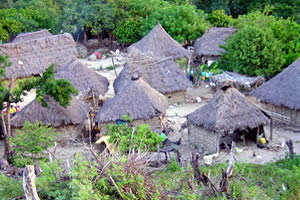The Kankuamo (Indigenous reservation)
The Kankuamo (Indigenous reservation)
The Kankuamo live in the foothills of the Sierra Nevada de Santa Marta, in the corregimientos of Atánquez, Guatapurí, Chemesquemena, Los Haticos, La Minha and Rio Seco, in the department of Cesar. Its settlement is in limits with the guards of the towns kogui, wiwa and arhuaco.
It has an estimated population of 4,000 people.
It is considered as a group related to the other towns of the Sierra Nevada, which after a long process of adoption and transformation of elements of Western culture, has begun to claim its status as an indigenous group. Initially this process generated some controversies with the neighboring ethnic groups, situation that has been surpassed by the dialogue and the intercultural agreements.
La Madremonte del Cabildo Indigena Kankuamo
Traditionally the Kankuamo were different from the other groups serranos by the dress - two crossed blankets for the women and short trousers and straw hat for the men -, by the calabazo that they used for their poporos and especially by their language, similar to the one Of the ika. The mamos, spiritual guides met in the Teruarica - male ceremonial house - to discuss the future of their community. However, from the first decades of the twentieth century the Kankuamo were considered as integrated into the larger society.
The reasons for the changes in their culture were manifold. Among these can be noted the location of its territory, easily accessible for colonization and establishment of missions since the first Spanish incursions. In addition, the insertion of Atánquez in the commercial circuits of the Caribbean region, a phenomenon that encouraged the arrival of immigrants and the changes in indigenous activities, displaced towards the production of cane and pot.
Within her worldview, the great universal mother created the world and her four children-kankuamo, ika, kogui and wiwa-to whom she assigned a specific territory in the Sierra Nevada. The Kankuamo were granted the area of the southeastern slope of the Sierra in the valley of the Guatapurí and Badillo rivers.
Like the other groups of the Sierra Nevada, they have in the figure of the mamo the maximum authority in the social and magico-religious level. The payment, an offering made to the ancestors, has now become the cultural axis to establish a continuity with its indigenous past. Depending on this activity, the Corpus Christi celebration ( (see photo on the right) is held to recreate their myths of origin and to re-emphasize the memory of sacred sites to make payments, usually large stones and dark pits.
The inhabitants of the different settlements are linked together by ties of kinship and compadrazgo. Politically, the Kankuamo are organized under the guidance of the Kankuama Indigenous Organization, OIK.
Its economic system is based on the individual possession of crops and animals for breeding. The men are in charge during the day of the work in the "rozas", located in the environs of the settlements. In the lowlands they plant plantain, banana and some fruit trees; In the highlands they grow potatoes and onions. For commercial purposes, they raise chickens and pigs. Women weave backpacks.
Arango y Sánchez. Los pueblos indígenas de Colombia 1997.
Dane: Censo 1993 -Proyección 2001-
Coronado C., Basilio. Historia Tradición y Lengua Kogui. Editorial Presencia Ltda., Santa Fe de Bogotá, 1993.
Correa, François. Sierras Paralelas, Etnología entre los Kogi y los U‘wa, en: Geografía Humana de Colombia. Tomo IV, Vol., 3, Santa Fe de Bogotá, 1998.
Pérez, María Luisa. Normas del sistema verbal de la lengua kawgian. Tesis de maestría. Posgrado en etnolingüística, Departamento de Antropología, Cela. Universidad de los Andes. Bogotá, 2001.
Fundación Hemera - Etnias de Colombia
Los Pueblos Indígenas de Colombia en el umbral del Nuevo milenio – DNP – Departamento Nacional de Planeación










